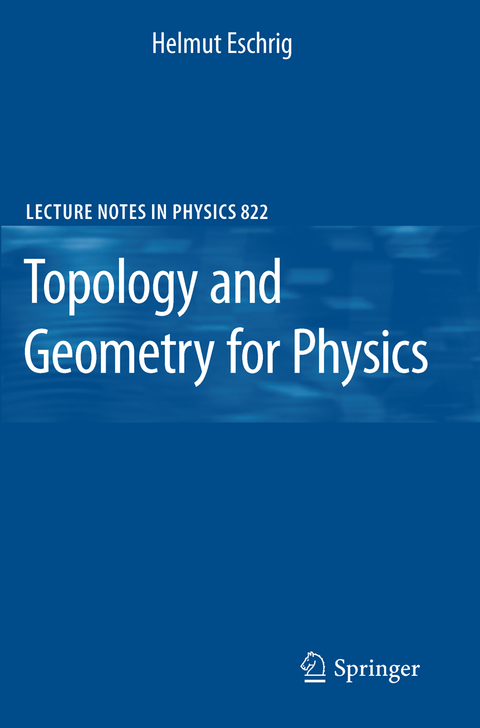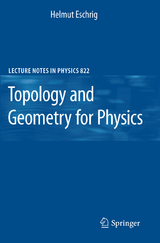Topology and Geometry for Physics
Springer Berlin (Verlag)
978-3-642-14699-2 (ISBN)
From the contents:
Introduction.- Topology.- Manifolds.- Tensor Fields.- Integration, Homology and Cohomology.- Lie Groups.- Bundles and Connections.- Parallelism, Holonomy, Homotopy and (Co)homology.- Riemannian Geometry.- Compendium
From the reviews:
"It consists of nine main chapters ... and the final Compendium which summarizes the volume in thirty two pages the basic geometric concepts and facts used in the book. ... the author really has achieved his purpose, namely he wrote a book rigorous in a mathematical sense, nevertheless not over-loaded by the physically non-necessary proofs and mathematical details, and at the same time giving to the reader a rigorous mathematical explanation of physical phenomena, often quite recently discovered and not commonly known." (Jan Jerzy Slawianowski, Journal of Geometry and Symmetry in Physics, Vol. 25, 2012)
"The author describes well the purpose of this text. It is to present to the theoretical physicist much of modern mathematics s/he may need ... with an emphasis on the motivation for the new concepts introduced. ... The resulting book achieves these aims to a large extent. The new concepts are motivated ... from physical examples before a precise definition is given. ... Altogether this book contains a lot of useful material ... written in a very concise style." (Hans-Peter Künzle, Mathematical Reviews, Issue 2012 a)
"The book is intended as bridging material between advanced graduate textbooks of modern analysis and mathematical physics ... . The text is of high quality and has the explicit aim to summarize and communicate current knowledge in an accessible way. The book mainly addresses students in solid state and statistical physics regarding the focus and the choice of examples of application, but it can be useful for particle physicists, too." (S. Moskaliuk, Zentralblatt MATH, Vol. 1222, 2011)
From the reviews:“It consists of nine main chapters … and the final Compendium which summarizes the volume in thirty two pages the basic geometric concepts and facts used in the book. … the author really has achieved his purpose, namely he wrote a book rigorous in a mathematical sense, nevertheless not over-loaded by the physically non-necessary proofs and mathematical details, and at the same time giving to the reader a rigorous mathematical explanation of physical phenomena, often quite recently discovered and not commonly known.” (Jan Jerzy Sławianowski, Journal of Geometry and Symmetry in Physics, Vol. 25, 2012)“The author describes well the purpose of this text. It is to present to the theoretical physicist much of modern mathematics s/he may need … with an emphasis on the motivation for the new concepts introduced. … The resulting book achieves these aims to a large extent. The new concepts are motivated … from physical examples before a precise definition is given. … Altogether this book contains a lot of useful material … written in a very concise style.” (Hans-Peter Künzle, Mathematical Reviews, Issue 2012 a)“The book is intended as bridging material between advanced graduate textbooks of modern analysis and mathematical physics … . The text is of high quality and has the explicit aim to summarize and communicate current knowledge in an accessible way. The book mainly addresses students in solid state and statistical physics regarding the focus and the choice of examples of application, but it can be useful for particle physicists, too.” (S. Moskaliuk, Zentralblatt MATH, Vol. 1222, 2011)
| Erscheint lt. Verlag | 9.2.2011 |
|---|---|
| Reihe/Serie | Lecture Notes in Physics |
| Zusatzinfo | XII, 390 p. 60 illus. |
| Verlagsort | Berlin |
| Sprache | englisch |
| Maße | 155 x 235 mm |
| Gewicht | 590 g |
| Themenwelt | Naturwissenschaften ► Physik / Astronomie ► Allgemeines / Lexika |
| Naturwissenschaften ► Physik / Astronomie ► Theoretische Physik | |
| Schlagworte | (Co)homology • Exterior calculus • fiber bundles • Geometric phases • Geometrie; Handbuch/Lehrbuch (Naturwissenschaften) • Riemannian Geometry • Topologie; Handbuch/Lehrbuch (Physik) |
| ISBN-10 | 3-642-14699-6 / 3642146996 |
| ISBN-13 | 978-3-642-14699-2 / 9783642146992 |
| Zustand | Neuware |
| Haben Sie eine Frage zum Produkt? |
aus dem Bereich




